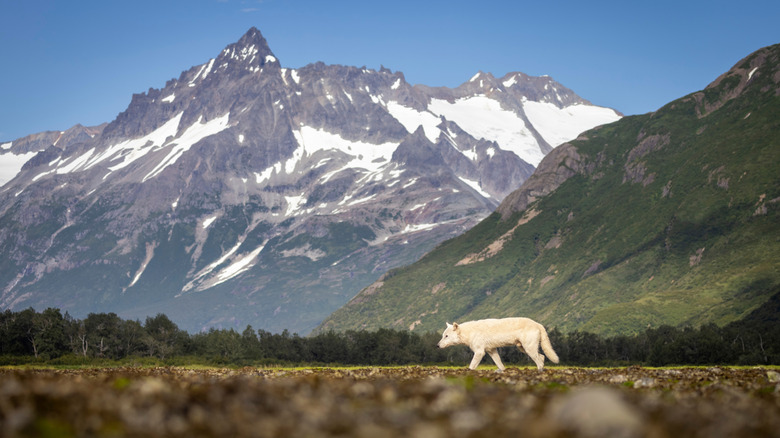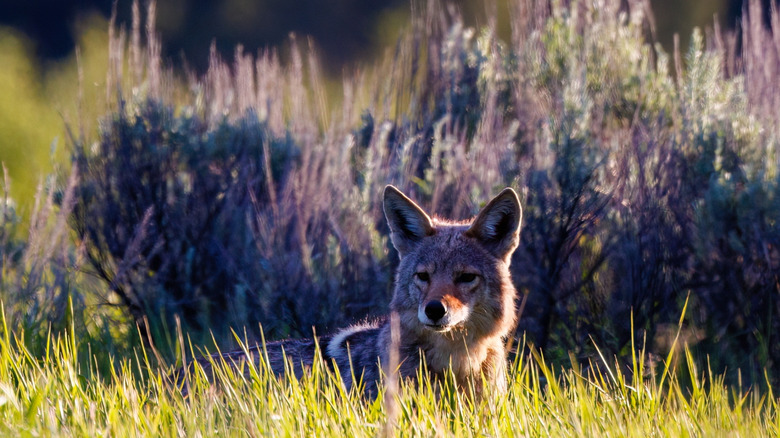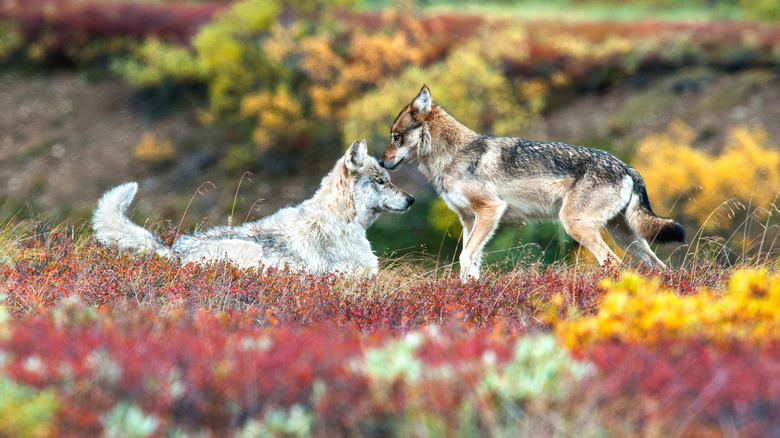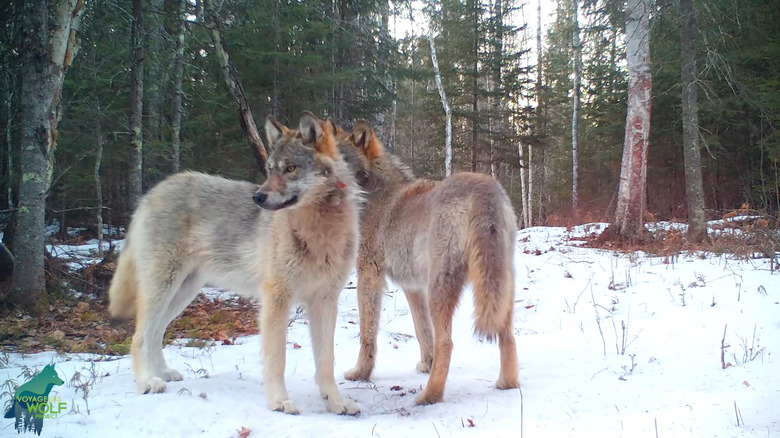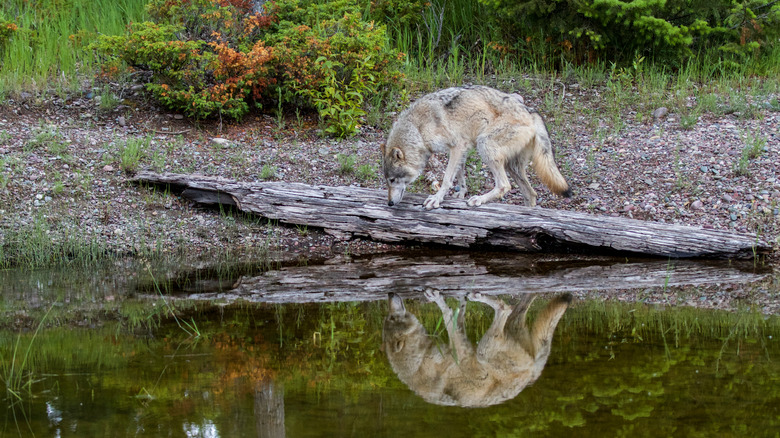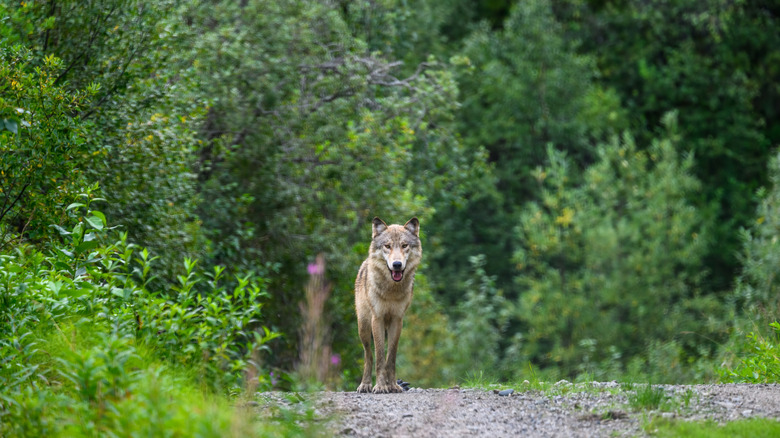5 Best US Parks To See Wild Wolves Roam (That Aren't Yellowstone)
If you're longing to hear howls at dusk or spot something large and gray loping across the landscape, you're going to need to seek out the few remaining places in the United States where you can still see wolves in the wild. Yellowstone National Park is probably the best place to go to try to spot wolves, to the point that the park even has a strict "No Howling" rule, to make sure that any wolves nearby aren't stressed out by guests trying to imitate their calls. If you don't want to go to Yellowstone, however, there are other options. While finding wolves may be more of a challenge, you may also spot them in Grand Teton National Park, Denali National Park, Voyageurs National Park, Glacier National Park, and Katmai National Park.
Wolf watching is quickly becoming a favorite recreational vacation activity, but finding them can be a challenge. There are certainly places, like New York's Wolf Conservation Center or New Jersey's Lakota Wolf Preserve, where you can book tours or attend programs to see wolves, but catching a glimpse of one, running wild through its natural habitat, is an incredible experience that many go their entire lives without having. These incredible creatures, once widespread in the United States, have been nearly wiped out because of both hunting by humans who hated and feared them and the destruction of the natural places that they once called home. National parks, like Grand Teton, Denali, Voyageurs, Glacier, and Katmai [pictured], make up some of the last remaining habitats for wolves, and if you're very lucky, when you visit, you might get to see one for yourself. Just remember: Stay 100 yards back from wolves. You can always use binoculars if you want a closer look.
Grand Teton National Park
Yellowstone National Park might be the gold standard for wolf watching, but don't overlook its neighbor. Less than an hour away is the beautiful Grand Teton National Park, which is known not only for its glorious mountain views but also its abundant wildlife. While it can't compete with the hundreds of wolves in Yellowstone, many have roamed outside of the park's borders to find their way to Grand Teton. The National Park Service reports that there were 46 or more wolves living free in Grand Teton at the end of 2024, and their numbers have probably grown since, as one of the six packs has been seen with new pups.
Most visitors who go to Wyoming's Grand Teton National Park never see a wolf, but to give yourself the best shot, consider going to the Willow Flats area at dawn or dusk. The Upper Willow Flats Overlook and the Lower Willow Flats Overlook provide views of meadows where many animals gather. You can see titanic sandhill cranes, baby elk, grizzly bears, and occasionally, wolves. Antelope Flats is another good place to check. While it's believed that wolves spend less time there now than they did in previous years, you will likely see pronghorns, bison, and elk, so it won't be a wasted journey.
Some travelers have also had luck spotting wolves by keeping an eye out for circling ravens, hoping to scavenge bits of a carcass from wolves after a successful hunt. If you're able to fit it into your budget, consider booking a private tour for around dusk with a guide who is a part of the radio network of wolf watchers who can take you to wherever they have been spotted that day. Make sure to specifically tell your guide that you want to see wolves.
Denali National Park and Preserve
Standing in the shadow of the towering mountains of Denai National Park and Preserve, looking beyond the bright red wild blueberry landscape to see the braided river beds beyond is an awe-inspiring experience that truly drives home how small you are in this wide expanse of Alaskan wilderness. According to a report from the National Park Service, there were 56 wolves living in Denali in 2024. Most visitors don't see wolves, and it's significant enough that when you do, you're supposed to report the details to the park. Denali is one of the largest national parks in the United States, but most visitors only see a small slice of it. The best way to explore Denali is on a bus along the park's single road, and it's also the best way to look for wolves.
From the higher vantage point of a bus, you have a better chance of seeing wolves than on the ground. The bus drivers are expert wolf spotters, and they communicate with each other, so they will know where and when to be on the lookout for wolves. Keep your eyes peeled as the bus goes through wide open areas like Sable Pass (between Mile 37 and 42) or areas with a good view, like Highway Pass (Mile 58.7), the highest area on the park road that lets you see far out in every direction. Choose bus tours that go as deep into the park as possible and try to go close to dawn for the best shot. If you want to see more wolves in the park in the future, consider supporting the Alaska Wildlife Allowance in their quest to maintain a buffer zone of protected land around the park to keep hunters and trappers from targeting Denali's wolves.
Voyageurs National Park
Minnesota's Voyageurs National Park is known for its waters, where you can take a kayak on the connected lakes and rivers to visit little forested islands and rocky coastlines. It's also known as one of the best national parks for stargazing and spotting the northern lights — but will you hear the howling of wolves echoing across the water while you're enjoying a night in this remote place? There are enough wolves in the park to make it possible. According to the National Park Service, there are between 30 and 50 wolves living in the park at any given time.
The wolf packs in this region are studied by the Voyageurs Wolf Project using hundreds of trail cameras and GPS collars on many of the wolves, which allow researchers to keep an eye on them and understand what their lives are like. They've learned a lot about this unique population of wolves, including how much of their diet is made up of blueberries and fish, more like what you might assume a bear would eat. Of course, most people who visit Voyageurs don't have access to that data, and most people don't get a chance to see the wolves. That doesn't mean that you can't find the wolves if you're determined enough.
The best chance to see wolves in Voyageurs National Park is to plan a trip there in the winter. This isn't an easy proposition, considering highs in winter months range from 14-22 degrees Fahrenheit and often drop down into the negatives. While wolves are usually most active at dawn and dusk, you may have better luck in the afternoon, because it's so cold. Head to the lakeshores during the warmest parts of the day. You might see them stalking their favorite prey: beaver.
Glacier National Park
The rugged landscape of Montana's Glacier National Park is so beautiful that it is sometimes known as the Crown of the Continent. This remarkable place may be best known for the Going-to-the-Sun Road, a scenic highway that cuts through the mountains to see jaw-dropping views of alpine lakes, waterfalls, and, of course, glaciers. But might you see a wolf pack running across the icy landscape from one of its overlooks? There are believed to be around seven packs in the park, but as recently as 2017, even some experienced park rangers who have spent years inside Glacier hadn't spotted one. That doesn't mean that it's impossible. Their range appears to be expanding within the park, so your chances are better now than they have been in over 100 years.
While you may not spot wolves along the iconic Going-to-the-Sun Road, you can take it to the intersection with Camas Creek Cutoff Road (sometimes just called Camas Road). Sometimes wolves are seen right along the road at dawn and dusk, but if you don't happen to spot one, don't worry. Camas Road takes you into North Fork, which is exactly where you want to be.
North Fork has the most wolves of any region of Glacier National Park. This remote part of the park is rarely visited, and it's easy to see why. There are only rough dirt roads, no cell service, and very little standing between travelers and the wilderness. You will likely have the best chance of seeing them in the winter, when the park is beautiful and still, but be aware that to get to North Fork at this time of year, you will have to take the gravel North Fork Road from Columbia Falls, and it's not plowed as quickly as major roads in Glacier.
Katmai National Park and Preserve
Katmai National Park is a remote Alaskan wilderness, only accessible by boat or plane, with a harsh, wild landscape forged from the eruption of an ancient volcano. It's also breathtakingly beautiful — but that isn't usually what calls people to make the journey to Katmai. It's the national park where you're almost guaranteed to see a bear, because the startling abundance of salmon that migrate through the park every year pulls these usually solitary creatures close together. But what about wolves? This is truly one of the best U.S. national parks to spot wildlife in general, and that includes wolves. While they may not be as well-known and abundant as the famous bears, the enormous, wild Katmai provides the perfect habitat for wolves to live their natural lives without human interference. Exactly how many wolf packs are roaming the park is unknown, but they love the fish in Katmai just as much as the bears.
If you're lucky, as you drive from Brooks Camp to the Valley of Ten Thousand Smokes, you might see a wolf from your car. Brooks Camp is famous for being the best place to see fishing bears, but you can also sometimes see wolves there catching salmon of their own. There is even a pair of viewing platforms where you can watch the river around Brooks Falls, which is the ideal, safe place to observe them on the hunt for fish. You can also spot wolves around the coast, where they love to prey on sea otters and harbor seals — something you can see in very few places on the planet. If you're heading to Katmai National Park to see the wolves, you're going to want to plan your visit for the summertime, when they are most likely to be seen.
